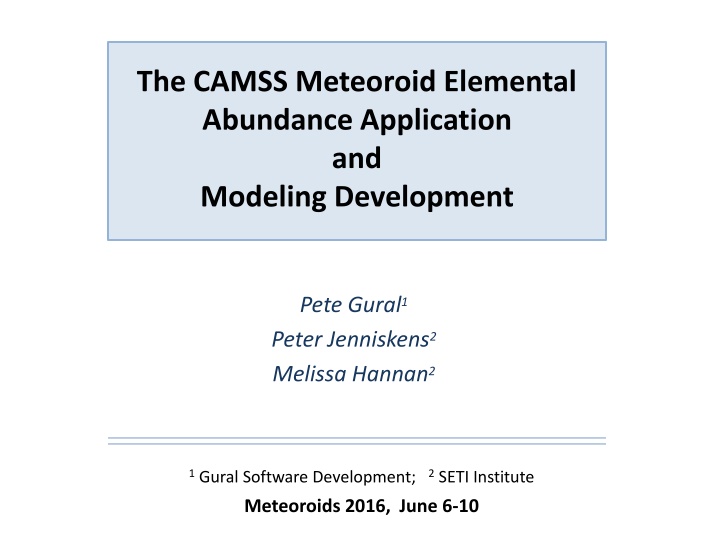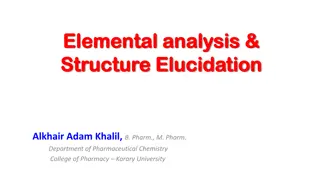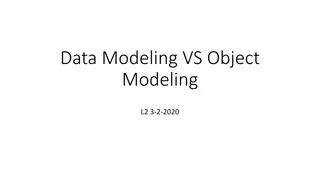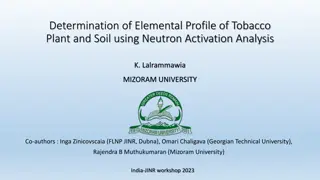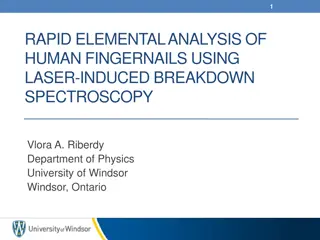CAMSS Meteoroid Elemental Abundance Application and Modeling Development
Cameras for All-sky Meteor Surveillance Spectroscopy (CAMSS) aims to obtain meteoroid elemental abundances through relative ratios and absolute atom counts, sampling from comets and asteroids. The system uses grating cameras with high resolutions to automate spectral analysis processes. The CAMSS Collection System in Sunnyvale, CA has been operating nightly since April 2013, with over 1000 spectra ready for analysis. Software tools like CAMS and CAMSS facilitate atmospheric track capture, spectral analysis, and abundance ratio calculations, with complete development for processing meteor spectra. Calibration processes involve adjusting responsivity and correcting for vignetting in the camera system.
Download Presentation

Please find below an Image/Link to download the presentation.
The content on the website is provided AS IS for your information and personal use only. It may not be sold, licensed, or shared on other websites without obtaining consent from the author.If you encounter any issues during the download, it is possible that the publisher has removed the file from their server.
You are allowed to download the files provided on this website for personal or commercial use, subject to the condition that they are used lawfully. All files are the property of their respective owners.
The content on the website is provided AS IS for your information and personal use only. It may not be sold, licensed, or shared on other websites without obtaining consent from the author.
E N D
Presentation Transcript
The CAMSS Meteoroid Elemental Abundance Application and Modeling Development Pete Gural1 Peter Jenniskens2 Melissa Hannan2 1 Gural Software Development; 2 SETI Institute Meteoroids 2016, June 6-10
Cameras for All-sky Meteor Surveillance Spectroscopy CAMSS Purpose is to obtain meteoroid elemental abundances Both relative ratios and absolute #atoms Sample across a diverse set of comets and asteroids Measure Mg, Fe, Na as well as other elemental species Scale up the number of high resolution spectra obtained All sky coverage with year round collection 16 Objective grating cameras with 0.6 nm/pixel resolution Automate the labor intensive spectral analysis process
CAMSS Collection System 1379 grooves/mm Pentax 12mm f/1.2 Watec 902H2 Ultimate 0.6 nm / pixel 1st order 0.3 nm / pixel 2nd order HP i7-3770 Quad-core w/16 channel capture/detect/store Operating in Sunnyvale, CA every clear night since April 2013 Over 1000 spectra ready to be analyzed
Software Tools and Applications CAMS - Atmospheric Track and Keplerian Elements Capture, Compress, Detect, Calibrate, Coincidence, Trajectory, Orbit CAMSS - Spectral Analysis Responsivity and Extinction calibrations Space-time coincidence relative to CAMS derived trajectory Spectra extraction, Element selection/fitting, Parameter tuning Abundance ratios and atom number density Software development complete Ready to process spectra q e i CAMS Elemental Abundances CAMSS
Calibration: Responsivity of the Camera System Captured Star Spectrum Adjust Grating Roll and Yaw Star Spectrum Provides Response Airmass < 1.5 Lab used as an Optional Response TBD: Planet or Iridium Flare Lab Measured Responsivity Catalog Star Spectrum 1 5000 1st Order 4000 0.8 3000 0.6 2000 0.4 Arcturus mv = -0.1 1000 0.2 0 2nd Order 400 500 600 Wavelength (nm) 700 800 900 0 400 500 600 700 800 900 Wavelength (nm) 1st Order Responsivity Response( ) = { star_rows [ StarPix(r,c( ) )) Backgnd(r,c) ] / Vignetting(r,c) } / StarSpectrum( ) / ExtinctionApprox( ) = ADU * m2 * nm / Watt / pixel
Calibration: Extinction and Vignetting Watec 902H2 w/12mm f/1.2 O2 O2 Vignetting correction is applied in focal plane space Image / cos4 ( 0.095 /pixel * ) Use star spectra for any air mass Average over multiple stars/days Extinction model fit components: Rayleigh O2 Ozone Dust Water Extinction( ) = AScale * exp{ - AR R - AO2 O2 - AO3 O3 - AD D - AW W } * Optical Depth at
Meteor Modeling Assumptions METEOR MODEL Plasma Radius Nominal Warm 4500 K Nominal Hot 10,000 K Assume Element s Abundance is the same in both Hot and Warm regions Nominal Hot/Warm Volume Ratio = 10-4 Hot Shock HTW = N( atom , Thot) / N( atom , Twarm) Optically Thin Warm Plasma Optically Thin Hot Plasma Column Density of Ions (or Neutrals) via Saha Electron density nelectron via Jones Assumes electron loss only from 1st air collision Assumes thermodynamic equilibrium Use fit elements + cosmic abundances nelectron via iteration on warm neutrals Provides first guess for iterative nelectron NIon / NNeutral = Jones, Neutral / ( 1 Jones, Neutral ) NIon/NNeutral = Saha[ ne, Twarm, IonEnergy( Neutral, Twarm), PartFunc( Neutral, Twarm), PartFunc( Ion, Twarm) ] = / ( 1 + ) = c( ) [ V Vo( ) ]2 V 0.8
SP_Coincidence Interactive View Measured Spectrum Model Spectrum Warm / Hot / Neutral / Ion Responsivity / Extinction Emission Line Fiducials 1st and 2nd order 350-660 nm 640-950 nm Imagery: Single-frame, Multi-frame, Movie Selection: Column Density, Hot/Warm, Xair Hb, Htie, He, Grating Roll, Pitch, Yaw Lines/mm, Line width, Twarm, Thot Element Selection CAMSS CAMS Coincidence Info
Work Flow: Trajectory and Spectrum Coincidence [1] Trajectory obtained from standard CAMS processing on ALL cameras [2] Temporally meteor must be within clock synchronization [3] Geometrically feasible to be within grating camera FOV in 1st or 2nd order wavelengths V hbeg hend beg, beg Grating Camera cam, cam end, end Define Spectral Hbeg and Hend For multi-frame integrated spectrum limits Tie Spectrum Time Slice to Trajectory Hframe For frame-by-frame abundance vs height
Work Flow: Select Element and Fit Model Spectrum Adjust Grating Pitch, Lines/mm, Select Reference Element (e.g. Na), Auto Fit Adjust Line Width (PSF ), Adjust Column Density SpectralFlux( ) = N( ) * lines { 1/ (2 ) ) * exp{ - ( ( ( ) )line )2 / 2 2 } * { PlasmaRadius2 / Range2 } * { 2 h e2 / o me 3 } * gf( ) * exp{ Eup( )line / kT } / U( ,T) =Watts / m2 / nm 1st Order Element s Neutral or Ion N( ) Column Density = # / m2T Twarmor Thot
Work Flow: Add Additional Elements, Molecules Add Element (e.g. Mg), Cosmic Abundance for Initial Flux, Adjust Column Density nelectrons = 6.9e+14 NNa = 3.6e+8 NMg = 3.0e+10 Na / Mg = 1.2%
Work Flow: Examine Neutrals & Ions, Warm & Hot Adjust Twarm, Thot, Hot/Warm Volume Ratio, and Column Densities Twarm = 5700 K Twarm = 4500 K Twarm = 3300 K Focal Plane Image
Work Flow: Frame-by-Frame Abundance Adjustment Re-Adjust Column Densities per Element, per Frame Na / Mg 1.6 % 1.5 % 1.4 % 1.0 % 1.2 % Column Density N Number Density n #atoms per element
Next Steps Begin analysis of the 1000+ spectra Modify procedures as we process a variety of spectral cases Solicit feedback on meteor emission modeling
